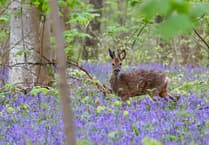Visitors flocked to Ludshott Common on Sunday to get a first glimpse of the long-awaited return of cattle grazing after more than a century.
Ludshott Common hosted an open day showcasing the reintroduction of conservation grazing to the site. The event, held at Dunelm car park on Sunday, September 14, gave visitors the chance to learn more about the long-anticipated return of cattle grazing, which will begin on the common in October. The return to grazing follows Ludshott Common becoming part of the newly formed Wealden Heaths National Nature Reserve, one of the King’s Series of National Nature Reserves.

National Trust rangers, estate managers, wildlife conservation experts, and graziers were on hand to answer questions about the project, explaining how British Shorthorn cattle will help control the growth of grasses, scrub, and bracken that threaten Ludshott’s rare lowland heath and wood pasture habitats.
Once grazed for centuries, the common has suffered from the decline of livestock since the 1920s. Encroaching scrub has endangered the open heathland and species that depend on it, including ground-nesting birds like the Dartford warbler, nightjar, and woodlark, as well as reptiles such as the sand lizard and adder.
Conservation grazing will also create microhabitats through the cattle’s dung and hoof activity, benefiting a wide range of wildlife. The heath’s ability to store carbon from the atmosphere adds further environmental value to the project.
“The introduction of cattle to Ludshott Common has involved a lot of hard work by many different partners, and we are excited to see the impact it will have on improving our heath,” said Lead Ranger Matt Bramich.
Visitors are advised to close gates behind them, keep a safe distance from the cattle, and keep dogs under control at all times. Under the common’s new National Nature Reserve status, dogs should be on a short lead from March 1 to July 31 to protect ground-nesting birds.





Comments
This article has no comments yet. Be the first to leave a comment.